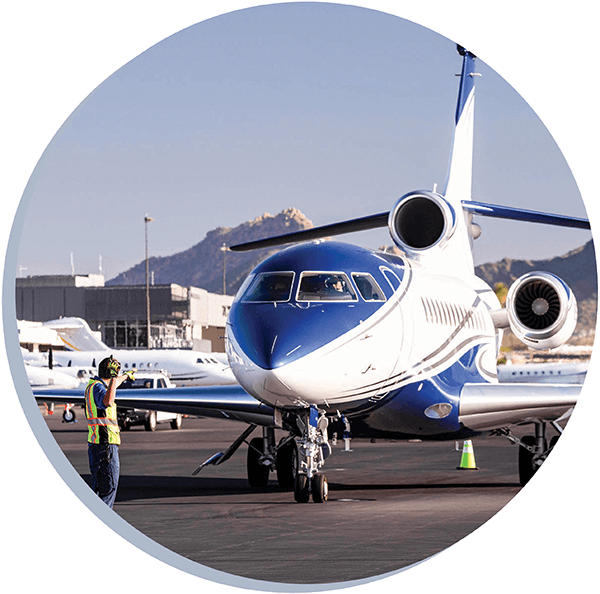Many factors can drive the decision to add larger, long-range aircraft to an existing flight operation. It’s important that the company flight department be an integral part of that process from the initial search through the final delivery.
“Companies often face evolving travel requirements that require larger and more capable aircraft to perform the mission,” said Phil Stang, former aviation director for a major entertainment venue. “In the perfect scenario, the reporting executive consults with the flight department and performs an analysis of the company’s needs. That level of thought doesn’t always enter into the mix, though.”
That can be particularly true when the decision is made for, perhaps, less pragmatic reasons. “Airplane envy is real,” said Eric Canup, head of flight operations for Live Oak Bank and chair of NBAA’s Domestic Operations Committee. “Sometimes, the flight department needs to slow people down and ask if there’s been a significant shift in its mission to warrant the change to a larger aircraft.”
Mike Ott, an international captain for Phoenix Air, emphasized the importance of applying change-management procedures when reviewing the need for a larger aircraft.
“[Change-management] must involve all aspects of the company,” Ott explained. “It behooves the flight operation to engage with every other department in the company when contemplating a change. Each department can then review the plan and determine if they have a stake in the process.”
That same process should then be maintained throughout the purchase and delivery process. While it may sound complex, “you don’t know what you don’t know,” Ott continued, “and you can’t begin to guess on your own all that will be needed. That is why you get the whole organization involved.”
“You need to develop your risk management strategy, and get buy-in throughout the department, long before you start flying international trips.”
Phil Stang Former Aviation Director for a Major Entertainment Venue
Different Missions and Needs
Canup recalled when his flight operation moved from a turboprop single to a transatlantic-capable business jet about 10 years ago to better meet the company’s expanding market presence.
“That marked a significant difference in how we operated,” he said. “Flying to Canada or the Caribbean isn’t really a big deal, but crossing oceans is very different and an education process in itself.”
Maintenance requirements will likely be more extensive and more expensive as well, including requirements to operate in different regions around the globe.
 “You will need to secure letters of authorization (LOAs) for international operating requirements,” Canup noted, “including controller-pilot data link communications (CPDLC) and reduced vertical separation minima (RVSM).”
“You will need to secure letters of authorization (LOAs) for international operating requirements,” Canup noted, “including controller-pilot data link communications (CPDLC) and reduced vertical separation minima (RVSM).”
Operators must secure proof of ownership prior to applying for an LOA, which may delay putting the aircraft into service after delivery. Canup noted the FAA is working to streamline that process, with certain allowances, with new aircraft deliveries.
“It’s like driving in England,” Canup continued. “The car drives the same, but all the rules are different. You must familiarize your department with those operations and receive the appropriate international training.”
Ott reiterated the number of company departments – from finance and insurance to facilities management, and even public relations – which may need to be involved in the decision process.
For example, “you’ll want to conduct a full-scale analysis of your facilities to ensure you’ve accounted for all the burdens the new aircraft will create,” he said. “That includes support equipment and the dimensions of your hangar and ramp space.”
Building a larger hangar to house the new aircraft also brings in the company’s finance department as well as airport leaders. “Even once the hangar is built, it’s not unheard of to realize you cannot turn the aircraft around on the existing taxiway,” Ott said. “You also need to know whether or not the pavement is stressed for that weight of aircraft. You don’t want the landing gear to sink into the asphalt!”
And while reviewing aircraft and crew insurance requirements will likely be on the aviation manager’s checklist, “has anyone considered the insurers of the passengers themselves?” Ott asked. “Flying overseas brings an entirely new slate of risk factors to the table.”
Shifting Training Requirements
Adding a new and more capable aircraft also changes the training requirements for flight department personnel and may also drive the need to bolster the existing workforce.
“Initiate training of your current workforce as soon as is realistically possible and analyze the need to hire additional personnel, including bringing people on board with experience and expertise with that platform,” Ott said. “You may want an ‘old pro’ or two to show you what they’ve learned.”
Crewing an intercontinental aircraft may also require a separate pool of pilots, flight attendants and maintenance personnel, to be filled either by direct hires or contract workers.
“You might end up inadvertently creating your own pilot shortage,” Stang said. “Companies don’t like having ‘extra’ employees around, but a larger aircraft may now require 4-5 pilots to perform a long-distance trip, even while you have another crew and aircraft back at home.”
 Stang also emphasized the importance of fatigue management. “You may not have ever needed to consider before how far you want to operate in a single day,” he said, “but crews can be stretched to their absolute limits on longer trips. The CEO may still want to get to the destination, attend a meeting and get out, but crossing all those time zones will wear you down.
Stang also emphasized the importance of fatigue management. “You may not have ever needed to consider before how far you want to operate in a single day,” he said, “but crews can be stretched to their absolute limits on longer trips. The CEO may still want to get to the destination, attend a meeting and get out, but crossing all those time zones will wear you down.
“Crews, especially, need time to rest and adjust,” he continued. “You need to develop your risk management strategy, and get buy-in throughout the department, long before you start flying international trips. You don’t want questions when you’re landing into a snowstorm with a crew that’s been awake 18-19 hours.”
Flight departments may also need to reconsider trips to popular destinations such as Aspen, CO, (ASE) that have aircraft size or ramp weight limitations, or may not have suitable parking space or support equipment to handle larger aircraft.
“The laundry list of potential issues gets bigger and bigger with the size of the airplane,” Stang said.
Ask Questions
To avoid such situations, flight department managers and staff should not be afraid to reach out to their peers, and others across the industry, for guidance.
“Be prepared for a learning curve,” Canup said. “When we made the change to a more capable aircraft, I didn’t know what I didn’t know – and it was a steep climb to the next plateau. Give yourself permission to show your ignorance, find resources and ask questions.”
“There are so many nodes you must touch, because you’re creating something no one else at your company has done before,” Ott said. “You must avail yourself of others’ expertise and not be afraid to ask for help; you are not alone. You can also work with your OEM. They’ve helped many operators work through these issues as they’ve delivered these aircraft.”
Ott also pointed to NBAA resources including the Safety, International Operations, Domestic Operations and Maintenance Committees. “The NBAA committee structure is full of people with experience in these kinds of operations who can help,” he said. “They’ve been there before.”
“I’m also a proponent of asking questions,” Stang agreed. “There are people out there who’ve been there and done that. Leverage that peer community. Reach out to your colleagues who may have experience with this transition.
“There’s a steep learning curve with these airplanes, and it can take years to learn it all.”
Review NBAA’s international flying resources at nbaa.org/intl.



 International Business Aviation Council Ltd.
International Business Aviation Council Ltd.